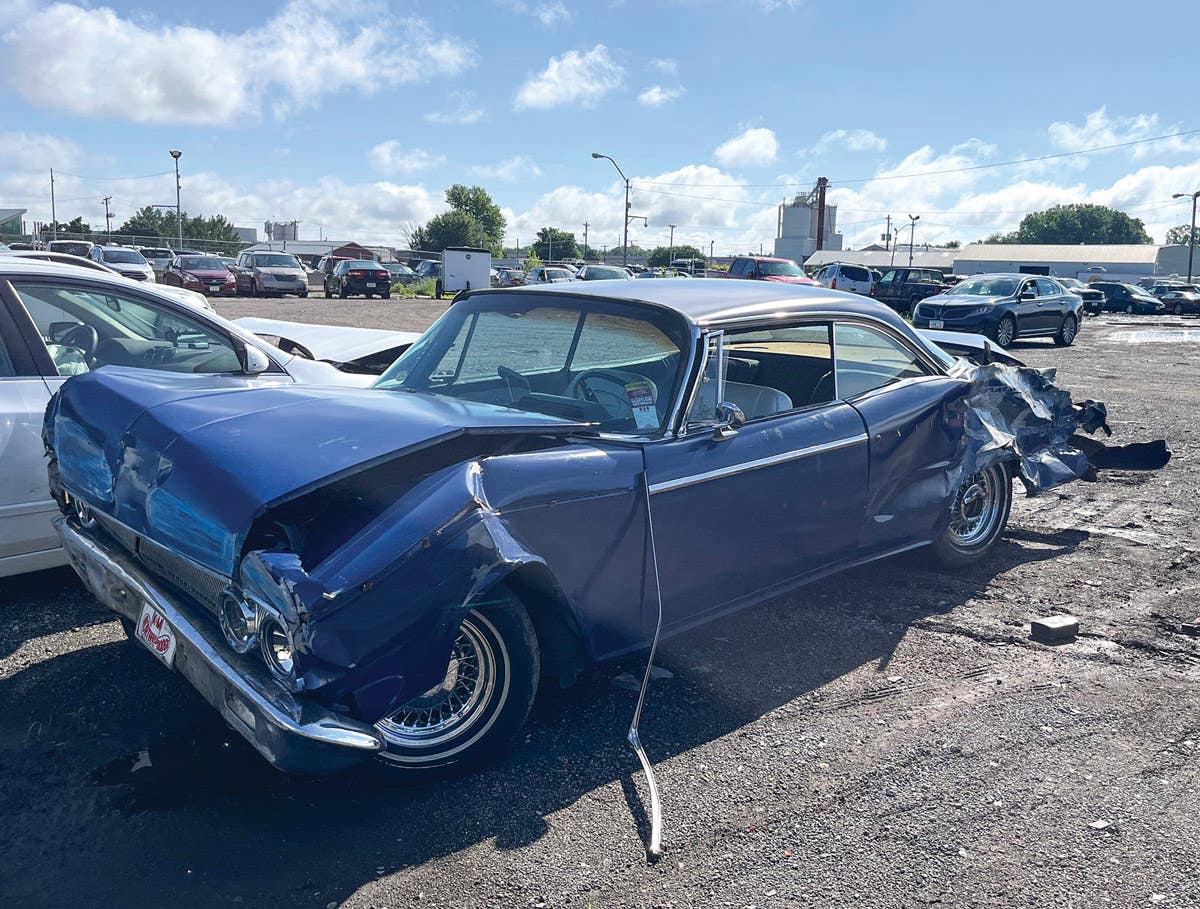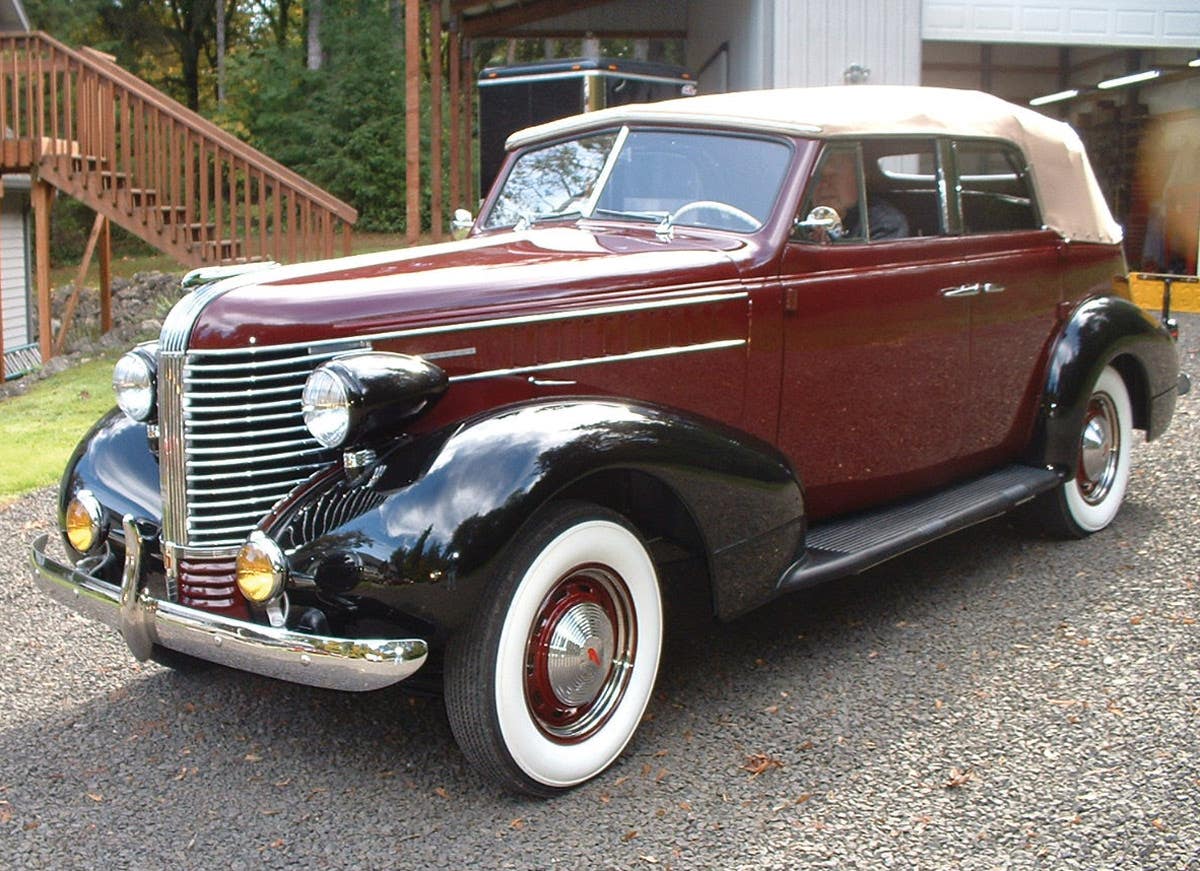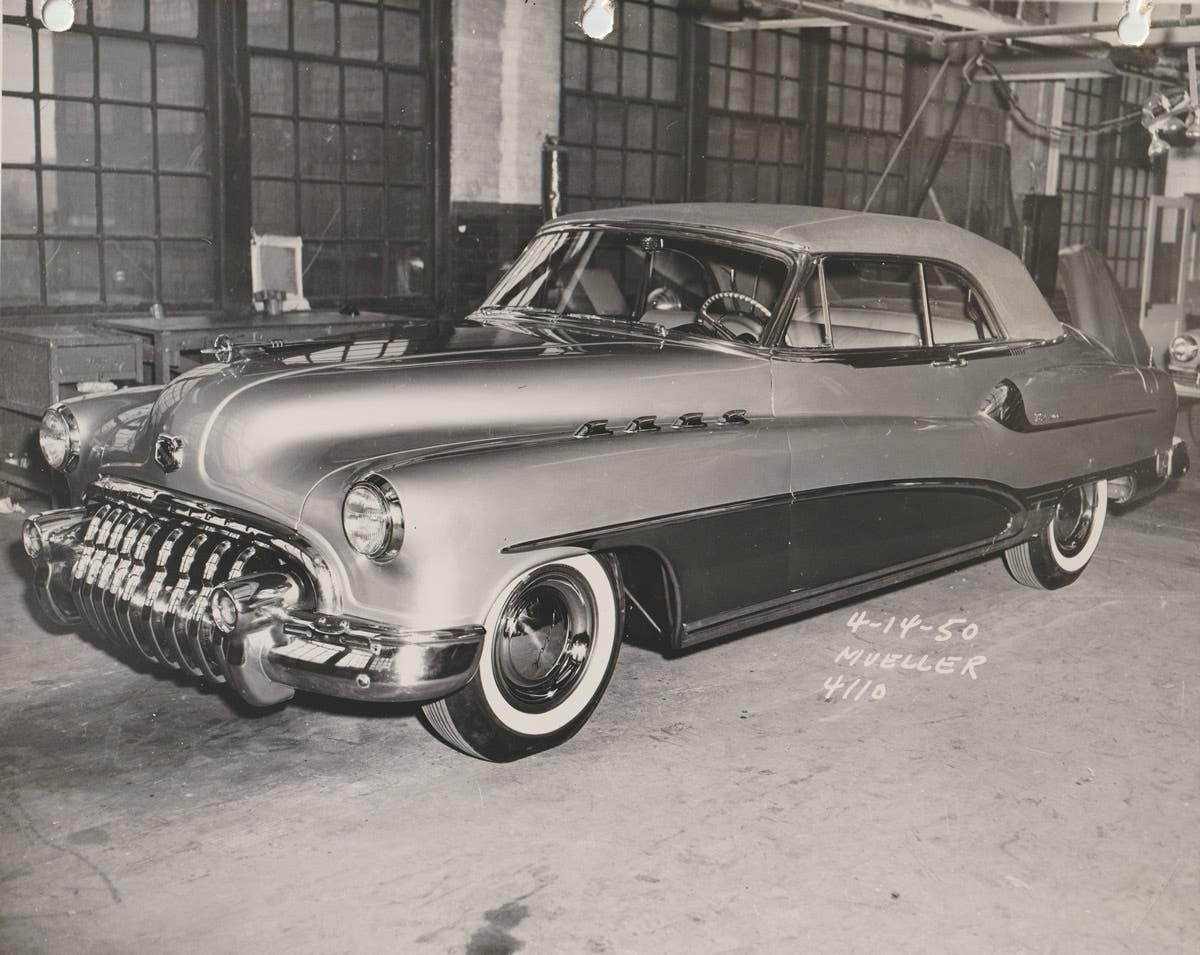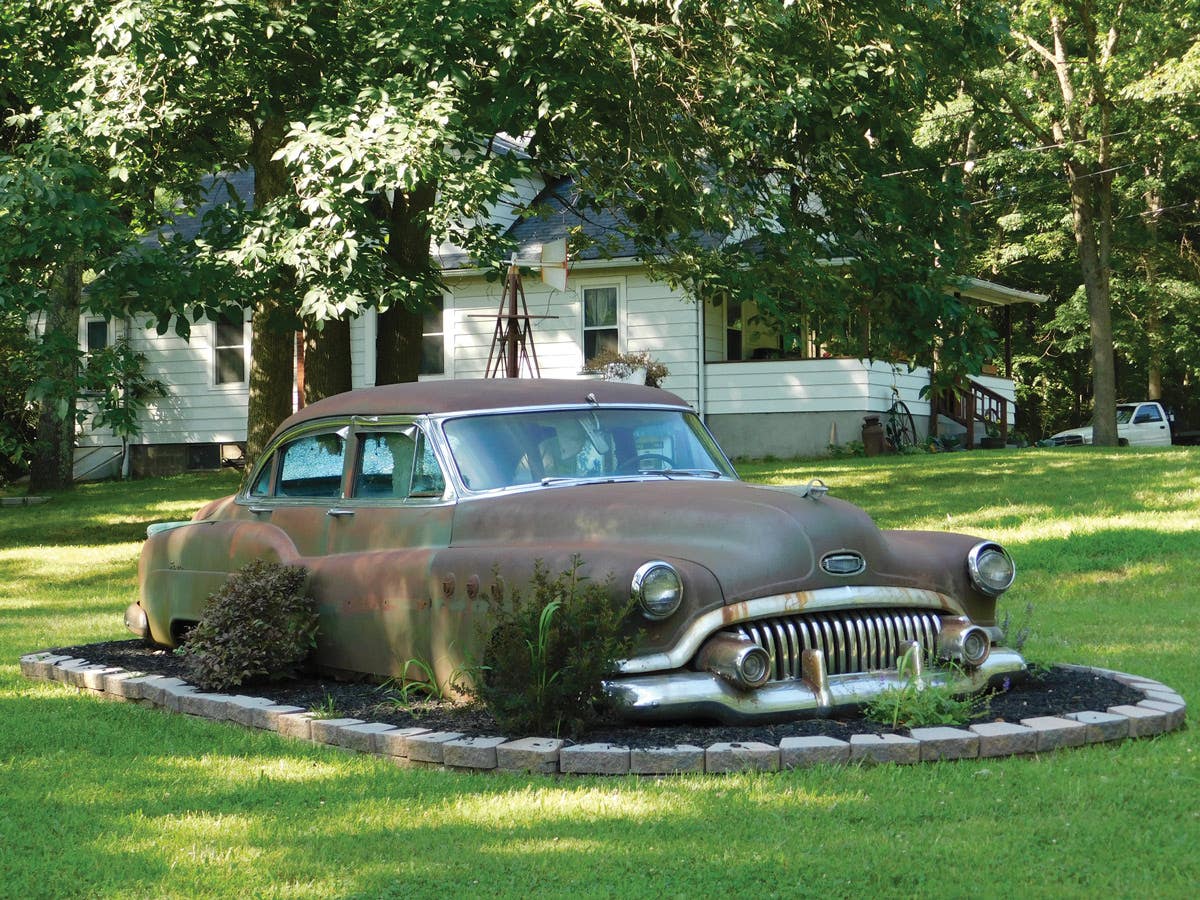The youth movement was in motion and Americans were getting “hipper” in 1957. American Bandstand, beatniks and Brigette Bardot were now part of the culture.
The 1957 Chevys were in tune with the times. They had a more youthful, tail-finned look that was “radical” for a once-upon-a-time bread-and-butter car. “’57 Chevrolet! Sweet, smooth and sassy,” said one ad.
Triple-Turbine automatic drive, a bigger V-8 and a bevy of new ideas including fuel injection made the ’57 Chevy seem revolutionary and sexy. True, it was based on the body introduced in 1955, but the latest version seemed more modern and sportier. Its oval-shaped front bumper grille featured “bomb-type” bumper guards. A horizontal bar “floated” across the delicately cross-hatched grille. Windsplit bulges with bombsight ornaments ran up both sides of the flat hood panel. The headlights had grilles around them. The rear fenders were shaped into broad, flat tail fins.
ll V-8 models, except those with stick shift, carried a new 283-cid V-8, which offered up to 283 hp in “super” fuel-injected format. All Chevrolets with a V-8 had large, V-shaped hood and deck lid ornaments (which were gold on Bel Airs). Very few cars carried the “fuel-injection” nameplate.
Extra rich in all ways, Bel Airs carried rocker sill, roof, window and tail fin outline moldings. Chevrolet scripts decorated the hood and trunk and gold Bel Air scripts and Chevrolet bow tie crests were on the rear fenders. Distinctive two-tone interiors were seen.
A total of seven V-8s were available and some were quite rare. Five of the 283s ranged from fairly hot to scalding. A four-barrel carburetor and dual exhausts gave the 220-hp Turbo-Fire 220 more muscles to flex. Dual four-barrel carbs were featured on the Turbo-Fire 245 V-8. Fitted with a Rochester mechanical fuel-injection setup, the Ramjet 250 version of the 283 engine was another choice. Next in horsepower was the Super Turbo-Fire 270, which combined dual Quadrajet carbs with a higher 9.5:1 compression ratio. Chevy’s legendary one-horsepower-per-cubic-inch Super Ramjet 283 was the top option combining the Rochester F.I. system with a 10.5:1 compression ratio. It was awesome and Chevrolet promoted this solid-lifter fuel-injection V-8 as the first American production-car engine to provide one horsepower per cubic inch of displacement.
Chevy tried to stay conservative when hyping horsepower in 1957 and there was a good reason for this. On April 10, a New Hampshire state senator made national news with charges that the auto industry was “engaged in a ridiculous and dangerous horsepower race.” By June 6, the board of directors of the Automobile Manufacturers Association recommended to member companies that they take no part in auto racing or other competitive events involving tests of speed and that they refrain from suggesting speed in passenger car advertising or publicity. So, Chevy ads mentioned “V-8s up to 245 hp” and then footnoted information about the 270-hp high-performance engine and 283-hp Ramjet fuel-injection engine in small print.
BEL AIR I.D. NUMBERS
The Chevrolet numbering system was also used on Bel Air with the same range of numbers seen for other lines, but with 'C' or 'VC' serial number prefixes.
NOTE 1: The V-8 was considered a separate series, not an option.
NOTE 2: V-8s are priced uniformly $100 above six-cylinder models.
NOTE 3: Data for six above slash/V-8 below slash.
ENGINES
SIX-CYLINDER: Overhead valve Cast iron block. Displacement: 235.5 cid. Bore and stroke: 3-9/16 x 3-15/16 inches. Compression ratio: 8.0:1. Brake horsepower: 140 at 4200 rpm. Four main bearings. Hydraulic valve lifters. Carburetor: (Powerglide) Rochester one-barrel Model 7007200 or Carter one-barrel Model 2101S; (standard shift) Rochester one-barrel Model 7007181. (The 'Blue Flame' six came with synchromesh, overdrive or Powerglide attachment.)
V-8: Overhead valve. Cast iron block. Displacement: 265 cid. Bore and stroke: 3-3/4 � 3 inches. Compression ratio: 8.0:1. Brake horsepower: (standard transmission or 'Touch-down' overdrive) 162 at 4400 rpm; (Powerglide) 170 at 4400 rpm. Five main bearings. Hydraulic valve lifters. Carburetor: (Powerglide) Carter two-barrel Model 2286S; Rochester two-barrel Model 7009910; (standard shift) Rochester two-barrel Model 7009909. (Note: This 'Turbo-Fire 265' was available as the base V-8 powerplant for 1957 Chevrolets with synchromesh or overdrive transmissions.) Other engines are listed under Powertrain Options below.
POWERTRAIN OPTIONS
According to the 1957 Chevrolet Passenger Car Shop Manual, six extra-cost power options were available in conventional (non-Corvette) models along with six gearbox selections. This provided a total of 17 optional engine/transmission combinations as follows:
NOTES:
F.I. - Fuel-injection. Transmission choices: (1) Three-speed manual; (2) Overdrive; (3) Regular Powerglide; (4) Turboglide; (5) Close-ratio three-speed and (6) Corvette-type Powerglide. H=hydraulic lifters. S=solid (mechanical) lifters. Corvette V-8s were not available in sedan deliveries. Lightweight valves were used only with SR high-performance camshaft and solid lifters. Some collectors maintain that a limited number of 1957 Chevrolet passenger cars came with four-speed manual transmission attachments, perhaps dealer-installed. This cannot be verified with normal factory literature. Cars with fuel injection engines wore special badges denoting this fact.
CHASSIS FEATURES
Wheelbase: 115 inches. Overall length: 200 inches. Front tread: 58 inches. Rear tread: 58.8 inches. Tires: 7.50 x 14 four-ply tubeless blackwall.
OPTIONS
Power brakes ($38). Power steering ($70). Overdrive ($108). Powerglide ($188).Turboglide ($231). Accelerator cover. Oil bath air cleaner. Air conditioner (V-8 only). Armrests for One-Fifty. Autronic Eye. Back-up lights. Chrome sill moldings. Park brake signal lamp. Power seat (except One-Fifty). Lighted cigarette lighter. Electric clock (except Bel Air). Eleven inch diameter heavy-duty clutch. Optional colors (paint or convertible top). Compass. Courtesy lights. Custom Color interior. Door edge guards. Door handle shields. Exhaust extension. Fender guards. Fender top moldings. Floor mats. Locking gas cap. Heavy-duty generators. Deluxe heater and defroster. Recirculating heater and defroster. Tinted glass. Glovebox lamp as option. Six-cylinder governor. Vibrator horn. License frames. Power convertible top. Vanity mirror. Oil filter. Chrome grille guard. Insect screen. Radio antennas. Radios (manual, push-button or signal-seeking). Rear speaker. Rain deflectors. Rearview mirrors (three-types). Seat covers. Ventilated seat pad. Electric shaver. Spotlights. Heavy-duty springs. Right-hand sun visor for One-Fifty. Whitewall and oversize tires. Tissue dispenser. Tool kit. Traffic light viewer. Trunk light. Underhood light. Continental wheel carrier. Wheel covers. Wire wheel covers. Power windows (except One-Fifty). Plastic windshield glare shield. Outside sun visor. Windshield washers (automatic or foot operated). De-icing wiper blades. Dual electric wipers. Wiring junction block. The fuel-injection V-8 was priced $484 over the base price of a six. Safety seat belts and shoulder harnesses were new options this season.
HISTORICAL FOOTNOTES
Dealer introductions for 1957 Chevrolets were held October 1956. Model year production peaked at 1,515,177 cars. Calendar year sales were counted at 1,522,536 units. Chevrolet outsold Ford by only 136 cars on a calendar year basis, but Ford actually built more 1957 specifications models than Chevrolet. It was a neck-and-neck battle between the two firms this season. Turboglide transmission was a running production change, so some early cars may have had 265-cid V-8s with Powerglide attachment. Chevrolet advertised that its solid lifter fuel-injection V-8 was the first American production car engine to provide one horsepower per cubic inch of displacement (283 cid/283 hp). This year the Chevrolet gas filler was incorporated into the chrome molding at the rear edge of the left-hand tailfin.
Collector Values
1957 Chevrolet Bel Air
Two-Door Sedan
No. 1 condition 39,500
No. 2 27,650
No. 3 17,780
No. 4 7,900
Four-door sedan
No. 1 condition 23,000
No. 2 16,100
No. 3 10,350
No. 4 4,600
Four-door hardtop
No. 1 condition 24,000
No. 2 16,800
No. 3 10,800
No. 4 4,800
Two-door hardtop
No. 1 condition 77,500
No. 2 54,250
No. 3 34,880
No. 4 15,500
Convertible
No. 1 condition 114,500
No. 2 80,150
No. 3 51,530
No. 4 22,900
Two-door Nomad
No. 1 condition 98,500
No. 2 68,950
No. 3 44,330
No. 4 19,700
Four-door Station Wagon
No. 1 condition 38,500
No. 2 26,950
No. 3 17,330
No. 4 7,700







